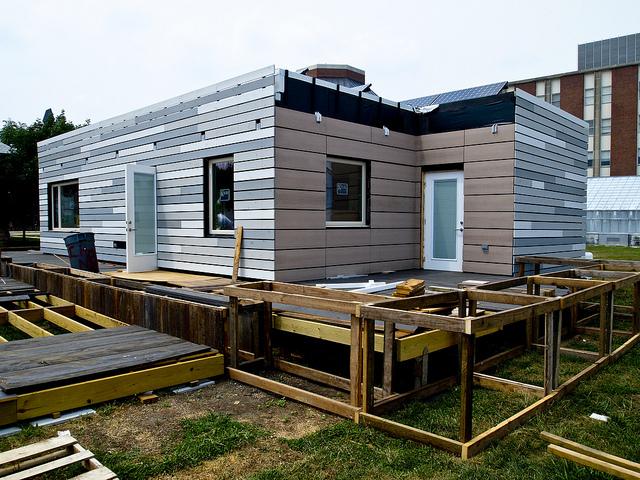Solar Decathlon Team Leading the Way Toward Sustainable Living—Even in the Wake of Disasters
Friday, August 26, 2011By April Saylor
Editor’s Note: This entry has been cross-posted from DOE’s Energy Blog.
In honor of the U.S. Department of Energy Solar Decathlon—which challenges collegiate teams to design, build, and operate solar-powered houses that are cost-effective, energy-efficient, and attractive—we are profiling each of the teams participating in the competition.

The Re_home is nearing completion. (Courtesy of the University of Illinois at Urbana-Champaign Solar Decathlon team)
For this year’s Solar Decathlon, the University of Illinois at Urbana-Champaign is returning to the National Mall with the Re_home, which offers a more sustainable housing solution for communities following a natural disaster. According to the team—which is aiming for balance between good design and smart planning—the Re_home responds to the physical and emotional needs of displaced families while demonstrating the ways environmentally aware living can be incorporated into a community-led recovery effort.
According to the Illinois team, what makes the Re_home different from previous disaster relief housing is the flexibility of the design. The Re_home is more adaptable to the various lifestyles of disaster victims than the typical mobile home-style trailer used in today’s disaster relief efforts. The Re_home offers an efficient and open floor plan that accommodates the various needs of many users. The floor plan was designed around one open area for public spaces and another area enclosed for private spaces, which encourages an open interaction between both interior and exterior spaces. This “flex space” allows the house to transition between a one- and two-bedroom home and also gives occupants several ways to customize the space.
This rapid-response solution for families affected by natural disasters uses low-cost materials and a straightforward construction plan, and the Re_home’s modular design allows it to be transported via trailer in two segments and erected quickly onsite. Its well-organized interior spaces; centralized, efficient appliances; and ease of transport and construction make this solar-powered house a great ready-to-deploy option for families as they rebuild after a disaster.
If disaster strikes, the house can be mobilized quickly to its new location and assembled within several hours to effectively shelter a family of four. The house is sealed by an insulated, double-layered building envelope that minimizes the transfer of heat and cold between the interior and exterior and drastically reduces its energy needs. That means the house becomes a livable space the day it arrives, providing new shelter for disaster victims.
In the following days, the rest of the house can be assembled by members of the community. The solar panels can be directed for appropriate sunlight angles—generating immediate electricity—a critical issue for those affected by natural disasters when power might not be restored or available for many days or weeks. The Re_home is also loaded with all-electric appliances, including a combination washer-dryer, refrigerator, dishwasher, and a combination oven-grill-steamer.
Coming from Illinois, a state centrally located in a tornado-prone region, the Illinois team hopes to be able to put its entry to use after the competition, which will take place on the National Mall’s West Potomac Park this fall. The Re_home could be offered to a family displaced by a tornado or other weather disaster, many of which roll through the state throughout the spring and early summer months every year.
For more information about the Re_home, visit the team’s website and blog.
April Saylor is an online content producer and contractor to the Department of Energy Office of Public Affairs.
Tags: Illinois, Solar Decathlon, Solar Decathlon 2011, Teams
